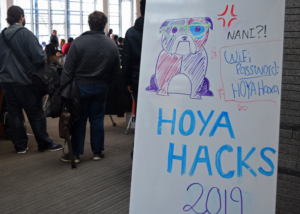A group of students that created a program to aid relief efforts for natural disasters won $500 at the fourth annual Hoya Hacks, which lasted from Friday evening until Sunday afternoon.
The 36-hour event invites undergraduates from any university to compete on teams to design projects and programs consistent with a particular theme. This year, students were encouraged to create projects focused on social impact. The competition offers multiple, more specific subdivisions of the general theme of the event, allowing students to tailor their projects to specific goals.

The winning group, The Plastic Chickens, created Project Reach, a program aiming to make it easier for potential donors to find charities and resources for those affected by natural disasters, according to the team’s website.
The Plastic Chickens is comprised of Alyssa Schilke, a junior at Loyola University Maryland; Sarah Kiel, a junior at Lehigh University; Collins Nji, a freshman at Frederick Community College and Adeeb Abbas, a freshman at Drexel University. Though many groups come to the competition formed already, the winning group met for the first time and formed at Hoya Hacks.
The project originated from the group’s desire to help those who were eager to provide for people in need, according to Nji.
“We know in Chicago, it’s so cold, and hospitals must be really overworked,” Nji said. “It all comes down to wanting to help people who you want to help but don’t know how. It’s hard when you have the resources and money and want to help people but don’t know how you can help.”
The website works by connecting people with charities, allowing them to track organizations by location and donate money.
“You can get close to the disasters happening. There’s a map in our program, where you can find the disaster and find charities where you can send money,” Kiel said.
The team competed in Hoya Hacks simply to enjoy a new experience, according to Nji.
“Honestly, it was more about just having fun. It was a learning experience, where we all learned something new related to web development and helping people in need,” Nji said. “This event is about working on a team in general, and also just having fun.”
Though proud of their finished work, the team ran into major problems after a glitch caused their entire program to stop working, according to Nji.
“We had made the whole application by 3:30 a.m., when I went to sleep. I woke up around 7:15, and I came back, did some minor changes, and the whole application broke,” Nji said. “We left 39 minutes to submission, and we literally figured out the problem five minutes before the submission deadline.”
One of the virtues of this particular hack-athon is the fact that students from multiple universities can meet for the first time and collaborate on a project for 36 hours together, according to co-director of Hoya Hacks Brandon Herren (COL ’21). Hoya Hacks reaches out to students at other universities by reaching out to student computer science organizations, Herren said.
Hoya Hacks was attended by around 250 people and sponsored by companies including Amazon Web Services, Microsoft, IBM, Verizon and Google, according to Herren. Representatives from major sponsors attended the event and provided insight to student hackers, Herren said. Participants in the event also had the opportunity to network with and have their resumes reviewed by sponsors of the event, some of which were prepared to offer internships to participants.
The hack-athon finds many of its participants through connections its established at universities around the country, according to co-director Aleida Olvera (COL ’20).
“We reach out to departments at other schools and their communication services,” Olvera said. “We contact every school in the D.C. area and the big schools on the East Coast. We have an established presence here in D.C. People know that Georgetown has a hack-athon and are interested in what it is.”
Hack-athons have been around for around 14 years, with the first hack-athon taking place in Calgary, Canada. The goal of a hack-athon is to bring programmers and designers together to complete a functional project in the time allotted. The Bay Area, which is home to companies such as Google and Apple, hosts hundreds of hack-athons. Hoya Hacks was founded four years ago to bring the culture of hack-athons to Georgetown, according to Herren.
“I’m personally from the Bay Area — I grew up in a culture of hack-athons,” Herren said. “We kind of wanted to bring the same kind of spirit to Georgetown. We wanted to give opportunities to all of these people who came to make projects and make them happen.”
Correction: This article has been updated on Feb. 8 to correct the name of Plastic Chickens team member Collins Nji.




















